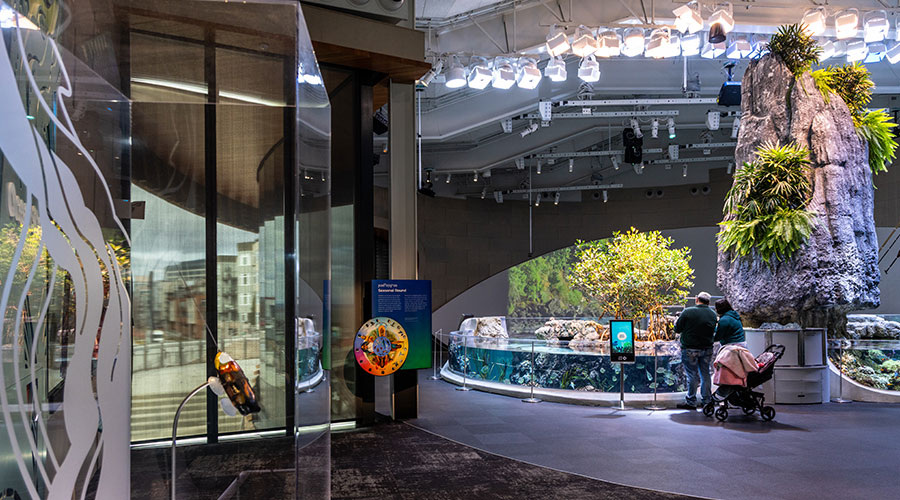Lighting and Signage: Critical Life-Safety Elements
To ensure signage and emergency lighting perform as intended, managers need to make certain they stay in working order.
By Dan Hounsell, Senior Editor
Emergencies in institutional and commercial facilities require that a range of systems and components function properly to protect occupants and assets. From access control systems and CCTV cameras to fire alarms and detection systems and extinguishers, critical components must perform as intended to ensure occupants can move through and out of a facility quickly and safely.
Two additional components critical to life safety — signage and emergency lighting — tend to get less attention but are just as essential in an emergency. In order to bring these components up to code, maintenance and engineering managers need to understand their roles in emergencies and take steps to make certain they stay in working order.
Signs of safety
Exit signs are designed to mark points of egress from buildings at times when occupants need help most. Complementing these life safety components are wayfinding signs, which help occupants move through buildings and toward exits when time is of the essence.
Unfortunately, in too many organizations, managers tend to overlook exit and wayfinding signs when assessing the emergency preparedness of their facilities.
"With the signage, a lot of times it goes unchecked,” says Michael Elliott, principal with Defense In Depth, a security consulting firm, adding that managers “don't necessarily walk the evacuation routes that are in the plans and discover that an exit sign is missing. Or we've got an exit sign that's now on a door that we access controlled so people now can't go out.”
One ongoing challenge managers face in ensuring the proper location and content of signage is that facilities constantly change.
“You have so many buildings that had a renovation here, a room change here, a door moved there,” says Michael Heroux, an energy engineer with FST Technical Services. “For whatever reason, the occupancy has changed a little bit. (Managers) have no clue if they've got the right emergency lights and exit signs in the right place. By not having the signage correct, it's telling people the wrong thing.
"I've seen so many places where you see signs, and they're not right. And then you have a healthcare organization where you’ve got to have interim life safety measures because you're doing construction, and you impact the stairwell, or you impact an exit. You need to make sure you know where your signage is and how to change it enough to let the people know.”
Heroux says effective signage is especially crucial in facilities such as hospitals, university dormitories, hotels and motels, which have longer-term occupancies.
“Any place where you got sleeping arrangements, you need to make sure that signage identifies the correct locations of the exits, the stairwells, the elevator, the lobby — areas that are critical to that building,” he says. “A lot of times, they're not very well developed or put together. You're not going to pay that much more to do it right.”
With the increasing frequency of active shooter events, managers also need to give signage special consideration related to its role in helping occupants stay safe, often while remaining in the building.
"There has been conversation about whether to have active shooter signage,” Elliott says. "A lot of times, (active shooters) are insider threats. They're current or former employees, so you don't really want to have a sign that says, ‘Shooter hiding spot’ because they're going to come straight there.
“You obviously want to hide somewhere where they can't see you or hear you. Some facilities have signage that says, ‘This is a storm shelter,’ or ‘This is a tornado room.’ A lot of facilities have quiet places and mother's rooms where there's no glass and you can lock the door from the inside. That's not necessarily considered emergency signage.”
To address these problem areas related to exits and wayfinding signage, managers need to take a comprehensive approach to signage inspection.
“It's time-consuming to walk down those plans, but I do see the signage being overlooked a lot of times when you're doing testing quarterly,” Elliott says. “Those plans and the equipment and the signage all need to be reviewed as part of a whole package so it’s all in sync.”
To achieve this goal, Heroux says managers should conduct an audit of life safety system components.
"Figure out where you're going, and make sure you bring an expert who knows how to put the signage together to meet the criteria for the organization,” he says. “If the organization is huge and they have an architect on site, that person might be able to help. But the majority of the time, you’ve got to bring in an outside expert.”
Spotlight on lighting
Given their need for power and integration with other critical facility systems, emergency lighting systems and components require additional attention beyond that given to signage. Elliott recommends that managers go beyond code requirements for system testing.
"A lot of places have fire codes or different types of permits that require a minimal amount of testing,” he says. “A lot of it is once a year, which is not enough. You should do it more often than that. Our recommendation is always that you should look at testing those systems quarterly. It seems like a lot, but you can test a lot of those at the same time with one type of drill."
Elliott also recommends a robust maintenance program for emergency lighting systems.
"Work with your facilities and maintenance teams to have a preventive maintenance program where you're checking on those things — the sprinkler systems, the emergency lighting, all those different types of things,” he says. “My recommendation is that especially in multi-level buildings, you do that on a quarterly basis, and you do it with drills along with your security team.
“A lot of the companies that I've worked with had security teams that were monitoring that equipment. It wasn't monitored by facilities. The fire alarms and that kind of stuff were monitored in the security or the emergency operations center. That partnership has to be there between whoever is responsible for that (role) and the facilities team and building owners.”
Many managers use computerized maintenance management systems (CMMS) to coordinate their departments’ maintenance activities. These applications can give managers crucial support in monitoring the condition and performance of emergency lighting, provided managers set up the systems correctly based on known hazards and activities in the facility.
“Make sure when you're programming those things that you're testing them before you fully put it into place and that your building owner and maintenance teams know the other things that are going on in the building and are working with contractors or employees to limit those false alarms,” Elliott says. “That triggers the complacency in the workforce with the students or you know whoever's there if you've got systems that are constantly going off because you don't have them tweaked inappropriately.”
The setup process also needs to include attention to high-priority tasks related to life safety.
“How you set up the emergency lighting and the exit lighting and all those components (in the CMMS) is very important,” Heroux says, adding that separating life-safety work orders from routine work orders enables technicians to deal with life safety work orders separately and ensure they are completed.
"They need to make sure that when they develop their processes, those are individualized as a type of work order on their own merit,” he says. “Then you can track them and know.” Without such emphasis on life-safety work orders, managers cannot be certain technicians have performed these critical tasks.
"They have no idea when the last person actually touched that emergency light or that exit light because they've done a generic check on that floor,” he says. “How do I know that the technician went to everyone on the floor, everyone in that wing? How you develop your processes and maintain these is very critical.”
Because emergency lighting and signage are so critical to emergency preparedness and occupant safety, Heroux says managers must pay close attention to replacement parts in the event a key element needs attention.
"Make sure you have spare parts available or a way of getting them quickly,” Heroux says. “With today's world of vandalism, in a dormitory room or a school district, someone can rip those lights down and impact the life safety aspect really quickly. Then you're sitting with a building that doesn't really meet codes and could be potentially a risk to the organization. Make sure you get a supply, and make sure that your technicians are trained on what they're supposed to do and how to service them and test them.”
Dan Hounsell is senior editor for the facilities market. He has more than 30 years of experience writing about facilities maintenance, engineering and management.
Related Topics:












